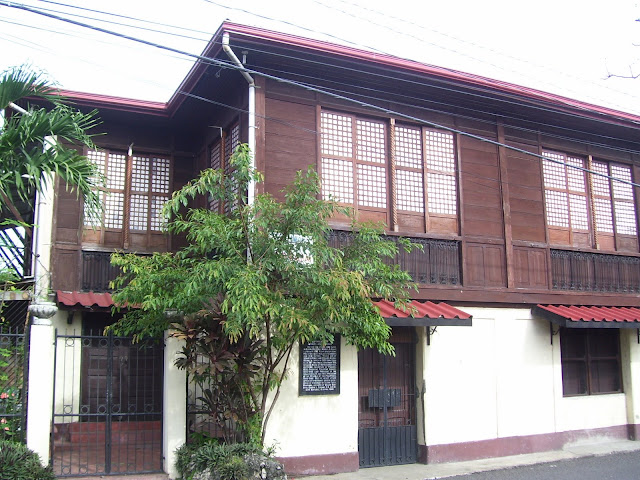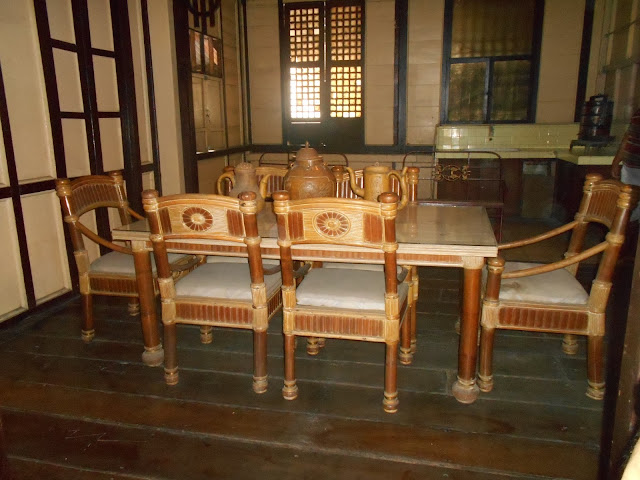The house that stands along Rizal corner Zamora streets a
few blocks away from the Roxas City Plaza is not just any other balay na bato. It stood the test of
World War II and made it through the ravages of innumerable typhoons that wrought havoc in this
part of the Philippines, but more than its quiet dignity, the home, typical of
its era and fitting for the wealthy of that time, saw the birth of one of the
most unforgettable figures in the history of twentieth century
Philippines—Manuel Acuña Roxas—Governor of Capiz, Speaker of the House of
Representatives and the first President of the Fifth Philippine Republic.
The house was not actually of the Roxases’, themselves imports from Manila. A look back at how a Roxas ended up in Capiz would do so much to give a little enlightenment. There was Doña Margarita Roxas de Ayala, dubbed as the richest woman in the Philippines in the mid-nineteenth century. So rich was she that her land holdings spread from Pampanga to Cebu. She opened the Philippines' first distillery, turning nipa palm into alcohol and purchased 5,000 hectares in San Esteban, Pampanga, near the present towns of Macabebe and Masantol. She journeyed herself to her various businesses as far as Cebu and Capiz (she purchased huge tracks of swamplands here in 1850). In Capiz, she sent her distant nephew, Antonio Roxas, to oversee her properties. Antonio’s son, Gerardo, married Rosario Acuña, eldest daughter and child of Eleuterio Acuña, also a non-native of Capiz.
The story of President Roxas’ birthplace is forever entwined
to the story of the Acuñas. To start with, there was Eleuterio, the pangayaw, and Ramona Villaruz, scion of
one of Capiz’s landed gentry and the tumandok.
Different accounts tell how he ended up in Capiz. Family oral tradition has it
Eleuterio was a tradesman who exported molasses from Capiz to Manila. According
to Fr. Rene Javellana, a descendant, he may have also been a Chinese-mestizo
from Binondo. Pres. Manuel Roxas’s biographer recounted that he was sent by the
Spanish Crown to oversee construction of public works in the area. Whatever the
truth may be, one thing is for sure, Don Eleuterio was that romantic pangayaw, smitten by the country lass
that was Ramona.
The surviving portrait of Don Eleuterio showing him seated
and flanked by her daughters reveals a man of varying features. He seemed European
in his poise and bearing but he also got that characteristic Chinese eyes. He
may be a mestizo, but it is unsure if he is a mestizo-Creole, or mestizo-Chino.
Don Eleuterio made friends with Don Manuel Barrios, a second
generation Capizeño, who convinced him to settle down in Capiz and forge a
fortune for himself. Eleuterio and Manuel got lucky with love, too, and married
the Villaruz cousins, Ramona and Leona, respectively. When Leona died, Manuel
married Ramona’s sister Rosa. Eleuterio and Ramona had twelve children. Unfortunately,
Ramona died after giving birth to their twelfth child. Eleuterio survived for
more years, amassing a sizable fortune, which he left to his children.
In the Ilaya part of the town of Capiz, Eleuterio built for
himself and his family that stone house with its expansive living quarters and
dining area. Here, on January 1, 1892, while the world outside was celebrating
the coming of the New Year, Rosario endured the labor pangs and gave birth to a
third son, Manuel. About nine months earlier, Rosario was widowed after Gerardo
was killed by a drunken guardia civil
during an altercation. It was Dona Rosario and Don Eleuterio who raised Manoling,
significantly shaping him to the great man he became later on.
The home where Pres. Roxas was born was passed on to Eleuterio’s
youngest daughter, Jovita, who married Conrado Barrios. In turn, the balay na bato was inherited by Jovita’s
second daughter, Ramona, who married Leopoldo Albar. Ownership devolved to
their son, Miguel and today it is maintained by his daughter, Emily.
The house is a typical balay
na bato—built of stone and wood, combining Spanish, Filipino and Chinese
elements. A fine house of that period, the home has solid stone foundations for
its lower walls, and overhanging, wooden upper story with balustrades and kapis shell sliding windows. A tour of
the house would begin at the ground floor, which used to be a garage and
storage area of the family. Today, it serves as an antique store which doubles
as the law office of the one the heirs.
Then, there’s the staircase, still sturdy, that leads to the
ante room and the expansive living room filled with heirloom furniture, which
have been with the family since President Roxas’s time. In fact, it seems
everything almost remains as if they were during the bygone years.
The family charges entrance fee to cover the cost of the
maintenance of the property, which is quite expensive. According to Emily,
before her father rescued the property, the house, just like any other old
house, fell into neglect and was in a state of near-ruin. Eventually, the
property was repaired and restored back to its former glory. It now bears the
marker of the National Historical Commission, a quiet reminder that this house,
which stood the test of time, saw the first cry of a visionary who helped shape
Philippine history.
How to get here?
If you’re in Roxas
Plaza, just walk straight ahead Rizal Street and you’ll see the house a few
meters away. If you are elsewhere in the city, just ask the driver to take you
to Rizal Crossing Zamora streets. The house stands in the corner. The house is
open from 10 am until 5 pm. The caretaker is at the antique shop in the
basement. A P50-peso entrance is charge per person.

.png)


















